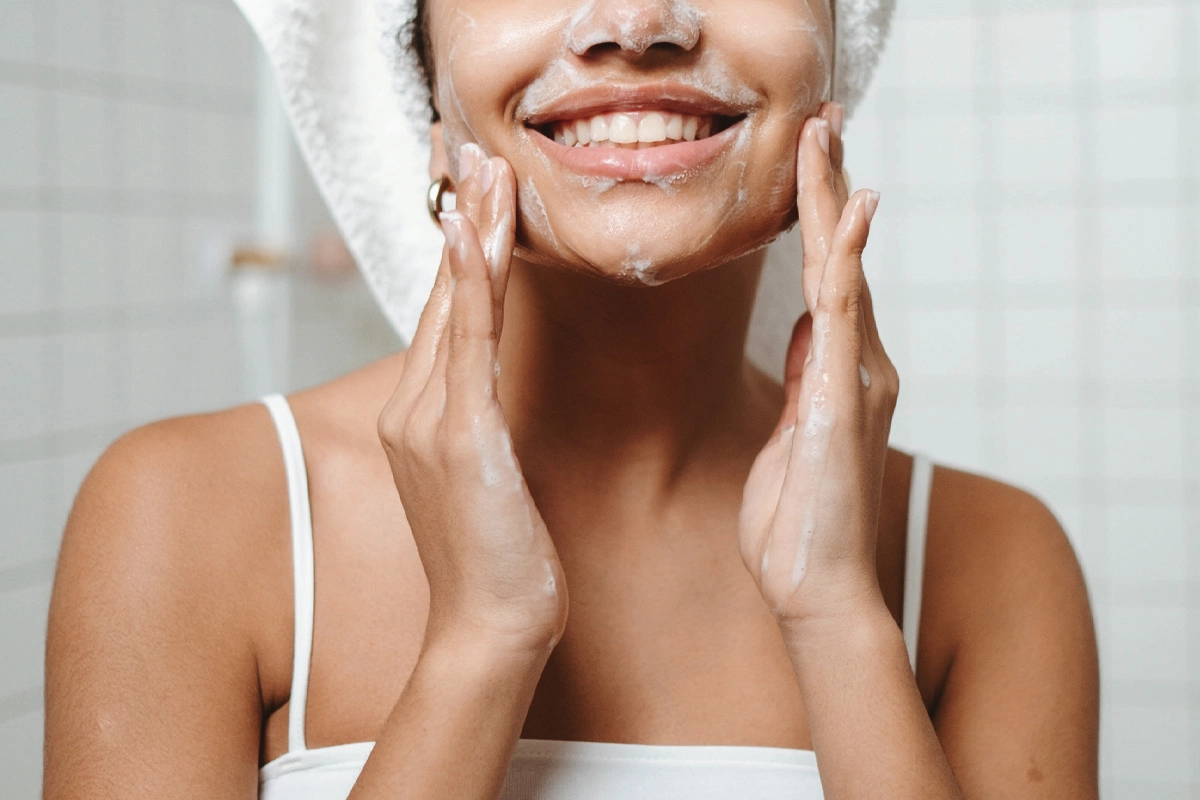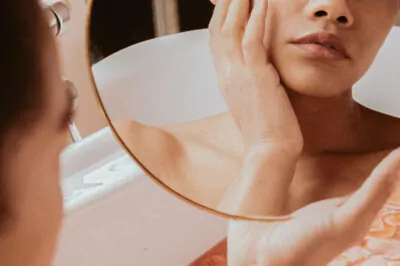Table of Contents[Hide][Show]
We’ve all been there. It’s the end of a long day, and cleansing feels more like a 10-second chore than a meaningful ritual. But what if we told you that this foundational step, the one most of us rush through, is often the one people get wrong, preventing them from seeing the best results from every single product that follows? It begs the question: is there really a “right” way to wash your face, and does it truly make a difference for your skin’s long-term health and glow?
The answer is a confident and resounding yes. This isn’t just about feeling cleaner; it’s about transforming the foundation of your skin care. Consider this your definitive, esthetician-approved guide to reframing your daily cleanse from a simple task into a powerful ritual. You’ll learn the exact techniques that support, honor, and truly elevate your skin.
The 4-Step Cleansing Ritual: An Esthetician’s Method

This isn’t just about washing your face; it’s about transforming a mundane task into a mindful ritual that connects you with your skin. Mastering these four simple steps is perhaps the single most impactful change you can make for a healthier-looking complexion, creating the perfect canvas for everything that follows.
Step 1: Start with the Right Amount on Damp Skin
Before you even begin, splash your face with lukewarm water. For a cream or gel cleanser, a dime-sized amount is the perfect starting point. Applying cleanser to damp skin is essential. Trying to use cleanser on a dry face is like trying to wash a greasy dish without water—it just drags and doesn’t work effectively. Damp skin allows the cleanser to properly emulsify, creating a gentle, milky lather that glides effortlessly and purifies deeply without pulling at your skin.
Step 2: The 60-Second Massage Rule
Here’s a non-negotiable step that separates a good cleanse from a great one: massage the product into your skin for a full 60 seconds. This isn’t about scrubbing harder — it’s about giving the cleanser’s beautiful ingredients time to do their work, helping to dissolve makeup, emulsify excess oil, and whisk away daily buildup. It also transforms a chore into a moment of mindful facial massage, encouraging gentle movement that helps relax your jaw and temples. This daily massage is a beautiful way to connect with your skin, and if you find yourself enjoying this ritual, you can elevate it even further by exploring the art of gua sha or facial massage — practices that bring a sense of calm and intention to your skin care routine.
Step 3: Use Gentle Pressure and Lukewarm Water
Your touch and temperature matter more than you think. Use the pads of your fingertips to cleanse in gentle, circular motions, and always rinse with lukewarm water. Water that’s too hot can feel harsh, disrupting the skin’s natural oils and leaving it feeling tight or uncomfortable. On the other hand, very cold water can make it more difficult to rinse away cleanser residue. Lukewarm water offers the perfect middle ground, helping to maintain your skin’s natural balance and comfort.
Step 4: Pat, Don’t Rub, Your Skin Dry
After such a gentle cleansing ritual, the last thing you want to do is aggressively rub your face with a towel. Rubbing can create unnecessary friction on the skin’s surface, which may leave it feeling sensitive or uncomfortable over time. Instead, gently pat your skin dry with a clean, soft towel. This simple switch helps maintain your skin’s natural comfort and leaves it feeling calm, refreshed, and perfectly prepped for the nourishing steps to come.
A Note on Cleansing Brushes and Tools

With so many cleansing gadgets on the market, it’s easy to feel tempted by the promise of a high-tech, deeper clean. They often claim to exfoliate away dullness and remove every last trace of buildup. But in the pursuit of that “squeaky clean” feeling, we can sometimes do more harm than good to the skin’s natural balance.
The reality is that your skin is protected by a delicate, intelligent barrier of lipids and beneficial flora. In our professional experience, the daily use of mechanical brushes — even soft ones — can be too abrasive for this barrier. This may contribute to over-exfoliation, which disrupts the skin’s protective oils and leaves it feeling uncomfortable or more reactive.
This is why we wholeheartedly believe the best tools for daily cleansing are your own hands. They offer something no device can: intuitive feedback. Your fingertips can sense where your skin feels dry or sensitive, allowing you to adjust your pressure in real time. Your hands also let you feel the unique landscape of your face — the contours, warmth, and subtle shifts that tell you what your skin needs that day. This transforms the act of cleansing from a one-sided action into a responsive dialogue with your skin.
If you do enjoy using a brush, reframe it as an occasional exfoliating treatment — once or twice a week is more than enough — rather than a daily cleansing necessity. For a mindful, gentle option, try our Lotus Wood Exfoliating Brush, designed to complement your routine without disrupting your skin’s natural harmony. And if you enjoy the feeling of touch as part of your ritual, you might also explore facial massage or Gua Sha as a mindful way to connect even more deeply with your skin.
Adapting Your Cleanse: A Guide for Your 30s, 40s, and 50s

A beautiful skin care ritual is one that evolves with you. The way you cleanse should honor your skin’s unique needs at every stage of its journey, because the support it requires in your 30s is quite different from what it craves in your 50s. Here’s how to adapt your approach for a truly supportive cleanse, decade by decade.
Skin Care for Your 30s: The Focus is Consistency
In your 30s, the theme is consistency. This is the foundational decade where the primary goal of cleansing is to establish a gentle, dependable ritual that will protect your skin barrier for the long run. It’s the perfect time to unlearn any harsh habits from your younger years and commit to a pH-balanced cleanser that your skin loves. Making this mindful, twice-daily cleanse a non-negotiable part of your routine is a cornerstone of building healthy skin throughout your 30s, setting the stage for decades of skin health to come.
Skin Care for Your 40s: The Focus is Nourishment
As you enter your 40s, the focus gently shifts from consistency to nourishment. Your skin’s natural oil production begins to slow, which means it can feel drier and less plump than it used to. Your cleansing ritual should evolve to reflect this. This is the ideal time to transition to creamier, more emollient formulas that cleanse effectively while helping skin feel supple and moisturized, never stripped. Cream-based formulas like our Aloe Herb Cleanser or Phytonutrient Cleanser are beautiful options for this stage—each designed to leave skin feeling soft, hydrated, and cared for. Thinking of your cleanser this way—not just as a way to purify, but as the very first step in replenishing your skin—is a vital part of an effective approach to skin care in your 40s.
Skin Care for Your 50s and Beyond: The Focus is Barrier Protection
For your 50s and beyond, the guiding principle of cleansing is gentle barrier care. At this stage, skin can feel thinner, drier, and more delicate, making it more sensitive to environmental stressors. The primary goal is to purify the skin while keeping its natural balance intact. Cream and oil-based cleansers become essential, and your technique is just as important—a soft, mindful touch is key. Formulas like our Restorative Cleansing Oil offer a nourishing way to cleanse while leaving skin feeling calm, comfortable, and beautifully cared for. Cleansing becomes not just a step in your routine but a comforting ritual that supports the look and feel of radiant, well-nurtured skin.
Your Cleanse: A Foundational Act of Self-Care
A proper cleanse is so much more than just washing your face. It’s the foundational act of your entire routine—a moment to gently remove the day and prepare your skin to receive all the beautiful nourishment that follows. It’s not about stripping the skin, but about creating a perfectly clean, balanced, and receptive canvas.
We encourage you to embrace your daily cleanse not as a chore, but as a cherished moment of connection with your skin. Let it be a chance to start and end your day with an act of intentional self-care, honoring your skin with the gentle, effective ritual it deserves.
After cleansing, your skin is perfectly prepped for the next steps. Follow with your favorite serums and a final layer of nourishment to lock in moisture. Depending on your needs, you might love a rich cream like our Restorative Facial Cream, or a targeted facial oil. The Anti-Aging Facial Oil is wonderful for mature skin, while the Rejuvenating Facial Oil helps restore harmony. You can explore our full Facial Oils collection to find your perfect match.
Frequently Asked Questions
How often should I wash my face?
For most people, cleansing twice daily is ideal. The evening cleanse removes impurities from the day, while the morning cleanse preps your skin for the products to come. The most important rule is to listen to your skin; if it’s extremely dry, a simple water rinse in the morning may be all it needs.
Should my skin feel tight after cleansing?
No, never. That tight, “squeaky clean” feeling is a sign that your cleanser is too harsh and has stripped your skin’s protective barrier. A proper cleanse should leave your skin feeling calm, soft, and comfortable—never stretched or dry.
Where does cleansing fit in my full skin care routine?
Cleansing is always the very first step. It creates a clean canvas and clears the way so that the potent ingredients in your serums and oils can be properly absorbed. This is why applying treatments after cleansing is key. This mention seems sort of random here, maybe just remove.






Leave a Reply